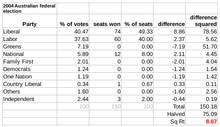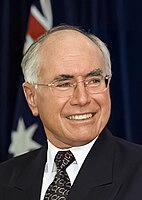2001 Australian federal election
| |||||||||||||||||||||||||||||||||||||||||||||||||||||||||
All 150 seats in the House of Representatives 76 seats were needed for a majority in the House 40 (of the 76) seats in the Senate | |||||||||||||||||||||||||||||||||||||||||||||||||||||||||
|---|---|---|---|---|---|---|---|---|---|---|---|---|---|---|---|---|---|---|---|---|---|---|---|---|---|---|---|---|---|---|---|---|---|---|---|---|---|---|---|---|---|---|---|---|---|---|---|---|---|---|---|---|---|---|---|---|---|
| Registered | 12,708,837 | ||||||||||||||||||||||||||||||||||||||||||||||||||||||||
| Turnout | 12,054,664 (94.85%) ( | ||||||||||||||||||||||||||||||||||||||||||||||||||||||||
| |||||||||||||||||||||||||||||||||||||||||||||||||||||||||
 Results by division for the House of Representatives, shaded by winning party's margin of victory. | |||||||||||||||||||||||||||||||||||||||||||||||||||||||||
| |||||||||||||||||||||||||||||||||||||||||||||||||||||||||
2001 Australian federal election |
|---|
| National results |
| State and territory results |
|
|
The 2001 Australian federal election was held in Australia on 10 November 2001. All 150 seats in the House of Representatives and 40 seats in the 76-member Senate were up for election. The incumbent Liberal Party of Australia led by Prime Minister of Australia John Howard and coalition partner the National Party of Australia led by John Anderson defeated the opposition Australian Labor Party led by Kim Beazley. As of 2024, this was the most recent election to feature a rematch of both major party leaders. Future Opposition Leader Peter Dutton entered parliament at this election.
Background
[edit]Throughout much of 2001, the Coalition had been trailing Labor in opinion polls, thanks to dissatisfaction with the government's economic reform programme and high petrol prices.[citation needed] The opposition Australian Labor Party had won a majority of the two-party-preferred vote at the previous election and had won a series of state and territory elections. Labor also recorded positive swings in two by-elections, taking the Queensland seat of Ryan and coming close in Aston.
However following the September 11 attacks, and the Children Overboard and Tampa affairs, Polls swung strongly toward the coalition after the "Tampa" controversy but before the 11 September attacks.[1]
In fact, voter concern with terrorism in the aftermath of the September 11 attacks in the United States was noted, with the rise in the combined primary votes of the major parties from 79.61% at the previous election in 1998, to 81.17% at this election. There would be further increases in the combined major party primary vote in 2004 and 2007.
Another major issue was the collapse of the country's second-biggest airline Ansett Australia and the question of whether it should be given a bailout. The Coalition was opposed to any bailout because the collapse was not the government's fault.[citation needed] However, Labor supported a bailout, because the company's collapse was about to result in the biggest mass job loss in Australian history, whilst also arguing that the government was partially responsible for allowing Ansett to be taken over by Air New Zealand, a move which had caused Ansett's failure.[2] Although the two-party preferred result was reasonably close, the ALP recorded its lowest primary vote since 1934.[3]
During the 2001 election campaign, Labor made a 'GST rollback' a centrepiece of its election platform. Labor attempted to reprise the effects of the birthday cake interview by deriding the application of GST to cooked and uncooked chickens, but failed to ignite public response to the limited scope of the rollbacks applying only to gas and electricity bills. the election loss of Labor in 2001, would effectively end all serious opposition to GST.
Political scientists[who?] have suggested that television coverage has subtly transformed the political system, with a spotlight on leaders rather than parties, thereby making for more of an American presidential-style system. In this election, television news focused on international issues, especially terrorism and asylum seekers. Minor parties were largely ignored as the two main parties monopolised the media's attention. The election was depicted as a horse-race between Howard and Beazley, with Howard running ahead and therefore being given more coverage than his Labor rival.[4]
The election-eve Newspoll forecast that the Liberal/National Coalition would get 53 percent of the two-party-preferred vote.[5]
Results
[edit]House of Representatives results
[edit]
Coalition
Liberal (68)
National (13)
CLP (1)
Opposition (65)
Labor (65)
Crossbench (3)
Independent (3)


| Party | Votes | % | Swing | Seats | Change | |||
|---|---|---|---|---|---|---|---|---|
| Liberal | 4,254,072 | 37.08 | +3.19 | 68 | ||||
| National | 643,926 | 5.61 | +0.32 | 13 | ||||
| Country Liberal | 36,961 | 0.32 | –0.00 | 1 | ||||
| Liberal–National coalition | 4,934,959 | 42.92 | +3.41 | 82 | ||||
| Labor | 4,341,420 | 37.84 | −2.26 | 65 | ||||
| Democrats | 620,197 | 5.41 | +0.28 | 0 | ||||
| Greens | 569,074 | 4.96 | +2.82 | 0 | ||||
| One Nation | 498,032 | 4.34 | −4.09 | 0 | ||||
| Independents | 332,118 | 2.89 | +1.00 | 3 | ||||
| Others | 178,274 | 1.64 | 0 | |||||
| Total | 11,474,074 | 150 | ||||||
| Two-party-preferred vote | ||||||||
| Coalition | 5,655,791 | 51.03 | +2.01 | 82 | ||||
| Labor | 5,427,569 | 48.97 | −2.01 | 65 | ||||
| Invalid/blank votes | 580,362 | 4.81 | +1.04 | |||||
| Turnout | 12,054,455 | 95.39 | ||||||
| Registered voters | 12,636,631 | |||||||
| Source: AEC Tally Room | ||||||||
Senate results
[edit]
Coalition
Liberal (31)
National (3)
CLP (1)
Opposition (28)
Labor (28)
Crossbench (12)
Democrats (8)
Greens (2)
One Nation (1)
Independent (2)
| Party | Votes | % | Swing | Seats won | Total seats | Change | |||
|---|---|---|---|---|---|---|---|---|---|
| Liberal/National Coalition | |||||||||
| Liberal/National joint ticket | 2,776,052 | 23.87 | +2.00 | 6 | 11 | ||||
| Liberal | 1,824,745 | 15.69 | +2.06 | 12 | 22 | ||||
| National | 222,860 | 1.92 | +0.06 | 1 | 1 | ||||
| Country Liberal | 40,680 | 0.35 | +0.03 | 1 | 1 | ||||
| Coalition total | 4,863,337 | 41.83 | +4.15 | 20 | 35 | ||||
| Labor | 3,990,997 | 34.32 | -2.99 | 14 | 28 [a] | ||||
| Democrats | 843,130 | 7.25 | -1.20 | 4 | 8 | ||||
| One Nation | 644,364 | 5.54 | -3.44 | 0 | 1 | ||||
| Greens | 574,543 | 4.94 | +2.22 | 2 | 2 | ||||
| Others | 630,600 | 5.44 | +0.22 | 0 | 2 [a] | ||||
| Total | 11,627,529 | 40 | 76 | ||||||
| Invalid/blank votes | 470,515 | 3.9 | |||||||
| Turnout | 12,098,320 | 95.7 | |||||||
| Registered voters | 12,636,631 | ||||||||
| Source: Federal Elections 1998 | |||||||||
House of Representatives preference flows
[edit]- The Nationals had candidates in 14 seats where three-cornered-contests existed, with 87.34% of preferences favouring the Liberal Party.
- The Democrats contested 145 electorates with preferences favouring Labor (64.13%).
- The Greens contested 145 electorates with preferences strongly favouring Labor (74.83%).
- One Nation contested 120 electorates with preferences slightly favouring the Liberal/National Coalition (55.87%).
Seats changing hands
[edit]The following table indicates seats that changed hands from one party to another at this election. It compares the election results with the previous margins, taking into account redistributions in New South Wales, Western Australia, South Australia, Tasmania and both territories. As a result, it includes the seats of Macarthur and Parramatta, which were held by Liberal members but had notional Labor margins. The table also includes the new seat of Hasluck (retained by Labor); the abolished Northern Territory, which was divided into Lingiari (retained by Labor) and Solomon (retained by the CLP); and Paterson, a Labor seat made Liberal by the redistribution
See also
[edit]- Candidates of the 2001 Australian federal election
- Members of the Australian House of Representatives, 2001–2004
- Members of the Australian Senate, 2002–2005
Notes
[edit]- ^ a b Shayne Murphy had resigned from the Labor Party on 2 October 2001 and served out the rest of his term as an independent.
- ^ For seats that were affected by the redistribution the Australian Electoral Commission calculated "notional" margins for the redistributed divisions by modelling the outcome of the previous election as if the new boundaries had been in place.[7]
- ^ Margin is over Labor.
- ^ Macarthur had become a notional Labor seat as a result of the redistribution.
- ^ Parramatta had become a notional Labor seat as a result of the redistribution.
- ^ Patersonhad become a notional Liberal seat as a result of the redistribution.
- ^ John Moore (Liberal) had won Ryan at the 1998 election, however he resigned in 2001 and Leonie Short (Labor) won the seat at the resulting by-election.
References
[edit]- ^ Issues that swung elections: Tampa and the national security election of 2001 The Conversation
- ^ "Tampa issue improves Coalition election prospects: ABC 7.30 report 4/9/2001". Abc.net.au. Archived from the original on 22 October 2008. Retrieved 13 June 2010.
- ^ "australianpolitics.com". australianpolitics.com. Retrieved 13 June 2010.
- ^ David Denemark, Ian Ward, and Clive Bean, Election Campaigns and Television News Coverage: The Case of the 2001 Australian Election. Australian Journal of Political Science. (2007) 42#1 pp: 89–109 online
- ^ "Newspoll archive since 1987". Polling.newspoll.com.au.tmp.anchor.net.au. Archived from the original on 3 March 2016. Retrieved 30 July 2016.
- ^ "2001 Senate national summary". Psephos Adam Carr's Election Archive. Retrieved 8 June 2022.
- ^ "National seat status". Australian Electoral Commission. Retrieved 13 May 2019.
- ^ "Electoral Newsfile 97: Seat Status including notional seat status for SA, NSW, Tas, WA and NT Divisions". Australian Electoral Commission. 2001.
External links
[edit]- Australian Electoral Commission Results
- University of WA Archived 18 January 2015 at the Wayback Machine election results in Australia since 1890
- AEC 2PP vote
- AustralianPolitics.com election details
- Preference flows – ABC




